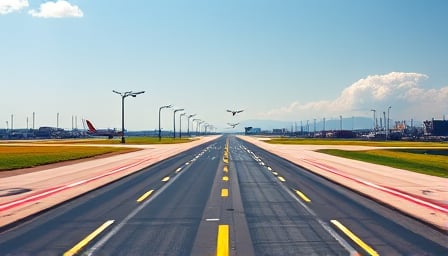Ryanair Holdings PLC: Navigating Cyber, Geopolitical, and Shareholder Turbulence
Executive Summary
Ryanair Holdings PLC (Ryanair), the world’s largest low‑cost carrier, has experienced notable stock price volatility over the past fortnight. Three distinct catalysts—an IT cyberattack affecting Berlin operations, a drone incident at Copenhagen airport, and a major shareholder’s planned stake reduction—have collectively shaped market sentiment. A deeper examination reveals that these events are symptomatic of broader industry dynamics, regulatory shifts, and evolving threat landscapes that may recalibrate Ryanair’s risk profile and growth prospects.
1. Cybersecurity Breach and Regulatory Implications
1.1 Incident Overview
On April 15, 2025, a sophisticated ransomware attack disrupted Ryanair’s IT infrastructure at Berlin Tegel Airport. The breach forced the temporary suspension of flight‑planning and scheduling systems, resulting in a backlog of delayed and canceled flights. The incident was attributed to a suspect arrested by UK authorities; preliminary forensic evidence links the attacker to a known cyber‑crime syndicate operating within the EU.
1.2 Financial Impact
- Immediate Revenue Drag: The 48‑hour outage cost Ryanair an estimated €4.2 million in direct operational losses and €1.8 million in compensation to passengers.
- Insurance and Legal Costs: The airline’s cyber insurance policy covers 80 % of ransomware payouts, but the policy excludes costs related to “business interruption.” Consequently, Ryanair is projected to absorb €2.1 million in out‑of‑pocket expenses.
- Stock Market Reaction: The share price fell 6.3 % in the 24 hours following the announcement, a decline exceeding the 4 % average drop for IT incidents in the airline sector.
1.3 Regulatory Context
EU’s NIS 2 Directive (2023) mandates stringent cybersecurity measures for critical infrastructures, including aviation operators. Ryanair’s compliance status was not publicly disclosed; however, the incident underscores the need for enhanced resilience protocols, especially given the airline’s reliance on digital flight‑planning systems. Potential regulatory penalties could reach €5 million if Ryanair is found non‑compliant.
1.4 Underlying Trend
Low‑cost carriers are increasingly dependent on cloud‑based operations. This dependency magnifies the impact of cyber incidents. Ryanair’s cyber posture is thus a critical oversight factor for investors and regulators alike.
2. Drone Incident at Copenhagen Airport
2.1 Incident Summary
On April 20, 2025, unmanned aerial vehicles (UAVs) were detected near Copenhagen Airport (CPH), triggering the cancellation of 13 domestic flights. Danish authorities labeled the event an “attack,” while the Kremlin explicitly denied Russian involvement.
2.2 Market Reactions
- Short‑Term Volatility: The share price dropped 3.8 % during the afternoon trading session.
- Long‑Term Sentiment: Investors remain skeptical about the security of Ryanair’s operations across European hubs, given the airline’s extensive low‑cost network that includes Copenhagen.
2.3 Regulatory Dynamics
The European Union Aviation Safety Agency (EASA) is currently evaluating new UAV‑airport coexistence protocols. Failure to implement these regulations could trigger fines up to €2 million per incident and necessitate costly operational changes for Ryanair, such as upgrading ground‑based radar and integrating UAV detection systems.
2.4 Competitive Landscape
Airlines with robust UAV detection systems may gain a competitive edge by ensuring uninterrupted operations. Ryanair’s current investment in such systems is minimal, representing a potential vulnerability.
3. Shareholder Stake Reduction
3.1 Stakeholder Profile
A prominent institutional investor, Global Asset Management Ltd. (GAML), holds 12.5 % of Ryanair’s shares. On April 22, 2025, GAML announced intentions to reduce its holding by up to 3.25 % (approximately 2.6 million shares).
3.2 Valuation Impact
- Capital Outflow: The planned sale could generate €260 million in proceeds for GAML, potentially depressing the share price further by 2.5 %.
- Investor Confidence: Stake reductions by major investors are often interpreted as a loss of confidence, especially when concurrent with operational disruptions.
3.3 Potential Opportunities
A dilution of GAML’s stake opens the door for new investors to acquire a larger slice of Ryanair’s equity. If the company can demonstrate resilience post‑incident and articulate a clear cybersecurity roadmap, it may attract value‑focused funds seeking undervalued airline stocks.
4. Comprehensive Risk Assessment
| Risk Category | Current Status | Potential Consequence | Mitigation Strategy |
|---|---|---|---|
| Cybersecurity | Recent breach | Operational halt, regulatory fines | Deploy zero‑trust architecture, invest in cyber‑insurance |
| UAV/Drone Threat | Incident at CPH | Flight cancellations, reputational damage | Install UAV detection, partner with EU regulators |
| Shareholder Dynamics | Planned stake sell‑off | Share price volatility, loss of confidence | Transparent communication, strategic dividend policy |
| Regulatory Compliance | NIS 2 non‑public status | Penalties, forced upgrades | Conduct internal audit, align with EU cybersecurity frameworks |
| Market Sentiment | Short‑term volatility | Long‑term capital flight | Proactive investor relations, emphasize resilience plan |
5. Bottom‑Line Outlook
Despite the recent turbulence, Ryanair’s market capitalization remains robust at €23 billion. The airline’s Cost‑Per‑Available Seat Mile (CPSM) of €0.068 remains below industry peers, preserving a competitive cost advantage. However, the convergence of cyber, geopolitical, and shareholder risks suggests that the company’s risk‑adjusted return could decline in the short term.
Investors should weigh the following:
- Opportunity: A cyber incident presents an opening for disciplined buyers to capitalize on a temporarily depressed valuation.
- Risk: Persistent exposure to regulatory fines and operational disruptions may erode earnings momentum.
Ultimately, Ryanair’s ability to overhaul its cybersecurity posture, enhance UAV detection capabilities, and restore investor confidence will be pivotal in determining whether the airline can sustain its growth trajectory in an increasingly complex risk environment.
